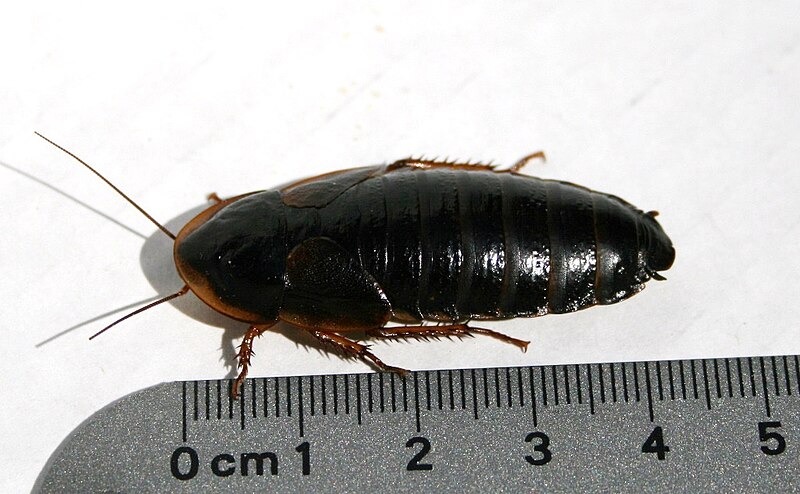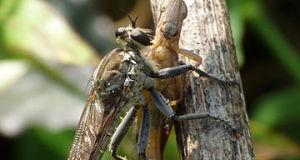 Hello, Frank Indiviglio here.
Hello, Frank Indiviglio here.
The orange-spotted or guyana roach, Blaptica dubia, often starts out as pet food but winds up as a pet. It’s small wonder, as these attractive insects are very interesting in their own right, and most agreeable to exhibiting their natural behaviors to the patient observer.
Coming into Their Own
Roaches are finally getting the attention they deserve from pet keepers, and even zoos are beginning to highlight them in exhibits. I housed many species at the Staten Island Zoo, and a new exhibit at the Bronx Zoo features a hollow tree stocked with thousands of Malagasy hissing roaches. But my favorite was set up many years ago at the Cincinnati Zoo’s groundbreaking Insectarium….visitors looked through a cutaway cabinet at a “kitchen” stocked with a colony American roaches. The huge insects were fed from cereal boxes, sandwiches left on a table and so forth…years later I tried to replicate this at the Bronx Zoo, for Norway rats, but the idea failed to impress my curator!
Classification and Diversity
Cockroaches, with a fossil record stretching back 300 million years, are classified within the order Blattaria (or Blattodea). Over 4,000 species have been described, and entomologists believe that as many more may be awaiting discovery. The largest species, Latin America’s Megaloblatta baberoides, sports a 7 inch wingspan while the heaviest, Macropameothia rhinoceros of Australia, weighs in at 1 ½ ounces. The lime green banana roach, Panchlora nivea, sometimes available in the pet trade, is to my eye the most attractive.
Orange-Spotted Roaches
The orange-spotted roach ranges from tan to reddish-brown and black in color, and is mottled with light orange dots. It reaches 1 ¾ inches in length. The natural range is usually given as northern South America, but there are records from as far north as Panama and as far south as northern Argentina.
As a Feeder Insect
This roach makes an excellent feeder insect as it rarely flies and cannot scale glass or plastic (unless either is very dirty!). Adults and juveniles alike have a soft exoskeleton, and are thus an ideal food for amphibians, birds, spiders, scorpions, fishes, reptiles and certain small mammals (I have used them as treats for flying squirrels and deer mice). The nymphs are only .1 inches in length, and eagerly accepted by tiny amphibians and reptiles.
CAPTIVE HUSBANDRY
Note: long term exposure to insect colonies may lead to sensitivities or allergies in some people. You may wish to consult your doctor in this regard.
Captive Habitat
The Enclosure
Orange spotted roaches can be housed in plastic terrariums, aquariums or sweater boxes. Sweater boxes should be ventilated with screened-over panels cut into the lids and sides. Fine-meshed “insect screening” is best, as the nymphs are quite small. Be sure that the mesh size on commercial terrarium lids is small as well – if unsure, add a second layer of finer mesh. The roaches can chew through some plastic screening, so use metal when re-screening.
Heat and Humidity
This species tolerates temperatures from 68-95 F, with breeding and growth being most rapid at higher temperatures. If you are interested in observing them, and not in producing large numbers as a food source, 75 F is ideal.
Heat may be provided by an incandescent bulb during the day and a reptile night light during the evening. I highly recommend the latter…the roaches will feed by day, but really put on a show at night, and a night light will allow you to observe them doing so. A ceramic heater or under-tank heater may also be used. In all cases watch that you do not over-dry the terrarium (keep an eye on shedding, please see below).
Orange-spotted roaches tolerate far drier conditions than do most of their relatives. Technically, they can run into difficulty in molting if a bit of humidity is not provided, but this is not common.
Misting the enclosure can result in the growth of mold and fungi, some species of which may be linked to colony failure. If conditions warrant it, mist lightly (glass only, not cardboard if such is used as a substrate) and be sure the glass dries within an hour or so.
Click: The Orange Spotted Roach: an Interesting Pet and Valuable Food for Reptiles, Amphibians, Invertebrates, Birds and Fishes – Part 2, to read the second part of this article.
Image referenced from Wikipedia Commons, here.
 That Reptile Blog – Reptile, Amphibian and Exotic Pet Care and Information
That Reptile Blog – Reptile, Amphibian and Exotic Pet Care and Information



Thanks for the article! Roaches have such a bad reputation that they’ve been very overlooked as a food source and as pets. If we hadn’t had this bias, they might have been available to the herp community decades ago.
Admittedly I was reluctant to get into them myself, because I imagined them getting loose – but I’m glad I have them now! I’ve never been able to get crickets to breed reliably, but I started a dubia colony a few months ago, and that’s going quite well. My agamas, palmatogeckos, and scorpions are enjoying them, and they are also very pretty of their own accord.
As you say, the dubias don’t climb and rarely fly, but they CAN if they really want to. I found one big winged male in my office once; he hovered out of the basin and came to find me. But weigh that against the dozens of crickets I’ve had to chase across my reptile room, and there’s just no comparison!
I’ve also added a small colony of Madagascar hissing roaches to my menagerie of late. They have just recently had their first batch of babies.
Which makes me wonder … how feasible would it be to create a multi-species terrarium of Madagascar hissing roaches, day geckos, and mantellas? I’ve had mantellas in the past, and would like to get into day geckos at some point. Seems like the roaches (at least the adults) would be too big to be bothered by either herp, and I think I recall that mantellas don’t have the skin toxins of the dendrobatids, so should not be a danger to their tankmates, but … what do you think?
Hello Raksha, Frank Indiviglio here.
Thanks for the kind words. I agree; roaches are far easier to manage and breed than are crickets, and very easy to nutrient-load as they eat so many foods. Dubia and a few others do not readily establish themselves in most homes should they escape.
Nice idea for a community tank – Hissers are very interesting when set up in a terrarium; males defend territories and 3-4 females. They might be too large to house with mantellas – likely would disturb/stress then as they moved about; but might be possible in a very large terrarium. Some roaches attack small animals (I’ve seen American roaches kill crickets and carry off small minnows), but hissers are mainly vegetarians.
Mantellas do have skin toxins, but they do not develop most unless they are fed certain types of millipedes, ants and other toxin sources. Larger day gecko species might try to eat a mantella, and injure or kill it. There may be an instinctive avoidance, however – I’m not aware of any trials so it would be an interesting experiment. I’d stay with smaller species. Also, you’ll need a very large terrarium, so that lights needed by the geckos will not over-heat/dry out the frogs. I enjoy community exhibits, but they take a good deal of planning, effort and space.
Good luck, enjoy and please keep me posted.
Best regards, Frank Indiviglio.
Thanks, Frank – it’s one of my goals to experiment with multi-species enclosures, but as you say, they will need to be fairly large. I could imagine a tall terrarium, so the geckos could hang out in the upper branches near the heat lights, while the floor is shaded and moist for the frogs and roaches. Something that tries to mimic their natural environment, since they are all from the same part of the world. Good point about sticking to a smaller species of day gecko – I will keep that in mind!
Hello Raksha, Frank Indiviglio here.
Thanks for the feedback. I think a tall tank would be an excellent option…please let me know how it goes.
Good luck and enjoy,
Best regards, Frank Indiviglio.
Just had to drop in here and say that that is a neat idea for a species combo. I’d drop the mantellas and try just day geckos and the hissers. One thing is for sure is that the geckos will have a neverending source of food. You might have to take out a few babies and rear them up to replace the adults if the geckos turn out to be too good of hunters.
~Joseph
Hello Joseph, Frank Indiviglio here.
Thanks for the input…good ideas. Community exhibits are a favorite of mine. I helped set up and then worked in a zoo building (Jungleworld at the Bx Zoo) that was 1 giant “mixed species exhibit” – gharials with gibbons, several turtles species, fishes, birds and flying foxes; otters with monkeys and birds, black tree monitors with turtles and fishes – tremendous headaches for years, but lots of fun!
Good luck and please keep me posted.
Best regards, Frank Indiviglio.